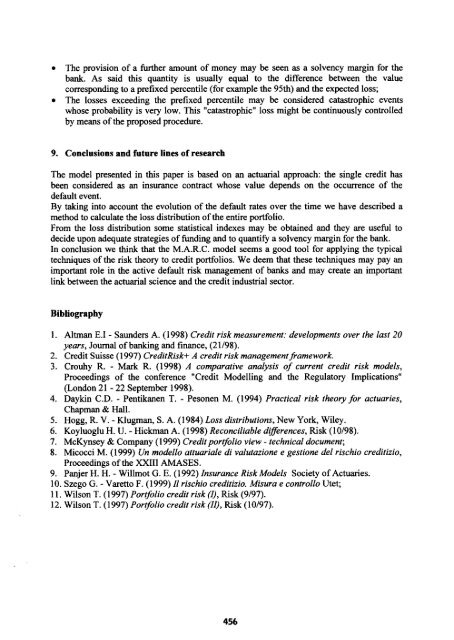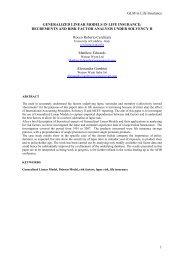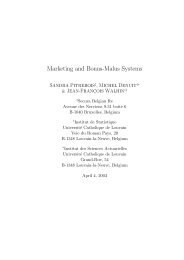M.A.R.C.: an Actuarial Model for Credit Risk - Proceedings ASTIN ...
M.A.R.C.: an Actuarial Model for Credit Risk - Proceedings ASTIN ...
M.A.R.C.: an Actuarial Model for Credit Risk - Proceedings ASTIN ...
Create successful ePaper yourself
Turn your PDF publications into a flip-book with our unique Google optimized e-Paper software.
0 The provision of a further amount of money may be seen as a solvency margin <strong>for</strong> theb<strong>an</strong>k. As said this qu<strong>an</strong>tity is usually equal to the difference between the valuecorresponding to a prefixed percentile (<strong>for</strong> example the 95th) <strong>an</strong>d the expected loss;0 The losses exceeding the prefixed percentile may be considered catastrophic eventswhose probability is very low. This "catastrophic" loss might be continuously controlledby me<strong>an</strong>s of the proposed procedure.9. Conclusions <strong>an</strong>d future lines of researchThe model presented in this paper is based on <strong>an</strong> actuarial approach: the single credit hasbeen considered as <strong>an</strong> insur<strong>an</strong>ce contract whose value depends on the occurrence of thedefault event.By taking into account the evolution of the default rates over the time we have described amethod to calculate the loss distribution of the entire portfolio.From the loss distribution some statistical indexes may be obtained <strong>an</strong>d they are useful todecide upon adequate strategies of fimding <strong>an</strong>d to qu<strong>an</strong>tify a solvency margin <strong>for</strong> the b<strong>an</strong>k.In conclusion we think that the M.A.R.C. model seems a good tool <strong>for</strong> applying the typicaltechniques of the risk theory to credit portfolios. We deem that these techniques may pay <strong>an</strong>import<strong>an</strong>t role in the active default risk m<strong>an</strong>agement of b<strong>an</strong>ks <strong>an</strong>d may create <strong>an</strong> import<strong>an</strong>tlink between the actuarial science <strong>an</strong>d the credit industrial sector.Bibliography1. Altm<strong>an</strong> E.1- Saunders A. (1 998) <strong>Credit</strong> risk measurement: developments over the last 20years, Journal of b<strong>an</strong>king <strong>an</strong>d fin<strong>an</strong>ce, (21198).2. <strong>Credit</strong> Suisse (1 997) <strong>Credit</strong><strong>Risk</strong>+ A credit risk m<strong>an</strong>agementfiamework.3. Crouhy R. - Mark R. (1998) A comparative <strong>an</strong>alysis of current credit risk models,<strong>Proceedings</strong> of the conference "<strong>Credit</strong> <strong>Model</strong>ling <strong>an</strong>d the Regulatory Implications"(London 2 1 - 22 September 1998).4. Daykin C.D. - Pentik<strong>an</strong>en T. - Pesonen M. (1994) Practical risk theory <strong>for</strong> actuaries,Chapm<strong>an</strong> & Hall.5. Hogg, R. V. - Klugm<strong>an</strong>, S. A. (1984) Loss distributions, New York, Wiley.6. Koyluoglu H. U. - Hickm<strong>an</strong> A. (1998) Reconciliable dzyerences, <strong>Risk</strong> (10198).7. McKynsey & Comp<strong>an</strong>y (1 999) <strong>Credit</strong>porrfolio view - technical document;8. Micocci M. (1999) Un modello attuariale di valutazione e gestione del rischio creditizio,<strong>Proceedings</strong> of the XXIII AMASES.9. P<strong>an</strong>jer H. H. - Willmot G. E. (1 992) Insur<strong>an</strong>ce <strong>Risk</strong> <strong>Model</strong>s Society of Actuaries.10. Szego G. - Varetto F. (1999) I1 rischio creditizio. Misura e controllo Utet;11. Wilson T. (1997) Porrfolio credit risk (I), <strong>Risk</strong> (9197).12. Wilson T. (1997) Porrfolio credit risk (II), <strong>Risk</strong> (10197).456




